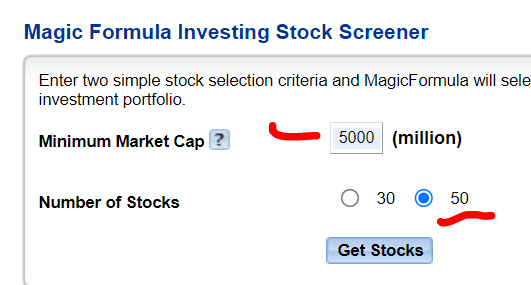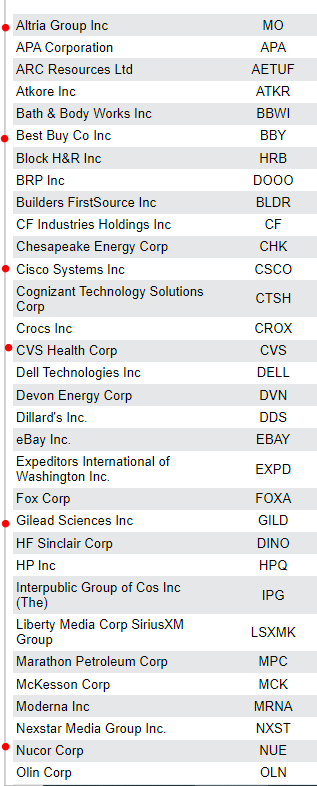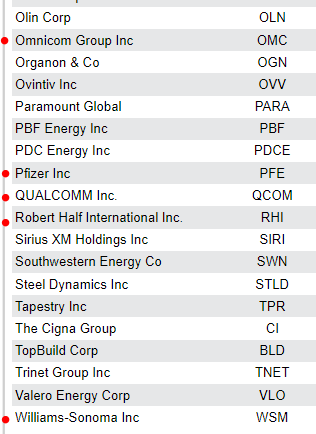Since recently giving up on my Magic Formula Portfolio, I feel like a burden has been lifted. I’m enjoying reinvesting these funds in companies that I believe in, especially those that pay growing dividends. But I haven’t completely abandoned Greenblatt’s Magic Formula. I still use the screener to identify stocks that I’m already interested in but that might be undervalued in the market.
Screener Settings

The default Minimum Market Cap is 50 million. I change it to… 5,000 million? That’s five billion dollars, people. It screens out the smaller companies that don’t usually pay stable, growing dividends. Then I choose to see 50 stocks.
Results
A couple of these stocks (Cisco and Nucor) are on the list of S&P 500 Dividend Aristocrats, meaning they’re in the S&P 500 and they’ve increased their dividends for each of the last 25 years. The 11 red dots next to the companies in the screen shots below, taken from MagicFormulaInvesting.com, indicate companies that have an established track record of paying market-beating dividends. I probably missed some.

Ha! I see old HPQ! I think they must have paid Joel Greenblatt a fee to permanently show up on his Magic Formula Investing site. HPQ’s dividend is 3.55% at time of writing by the way. The results continue:

I personally invest in many of these. When you have a portfolio of many stocks it’s easy to lose track of them. Occasionally taking a look at this site can help to identify stocks of interest that that may be undervalued in market.
Hi Andrew,
We had contact before about the random stock picking. I have committed to the MF for about 13 years now and LOST around 30% of my invested money. Not really the promise the book gives us. I used the over 50M market cap screen for the highest returns. What market cap did you use?
Also about to give up now. But I am curious if you found any other stories about experience with the official screener (maybe it worked better above 1B dollar). It’s difficult to find any other experiences.
Hope to hear from you,
All the best,
Wouter , the Netherlands
Hi Wouter!
Please forgive the lateness of my reply. That’s crazy that you LOST 30% – at least I was profitable. And I too used the minimum market cap of $50 million, because that’s what Greenblatt used in the book.
I have not heard any stories about how to use the screener more effectively; only speculation such as “if you remove biotech companies it will work!”. Sorry Wouter. I’ve actually been trying to develop my own screener but so far it has trailed the SPY. I promise to write a post on this soon!
Take care,
andrew
Hi. Before you bet your real money on any formula, you should understand how it works. Magic Formula doesn’t work because of a one simple reason. Just look how the Return On Capital is calculated. Greenblatt’s ROC formula assigns high ranks to stocks that have a lot of Goodwill it their balance sheet. Aggressive acquirers with tons of Goodwill gets top ranks, but companies that are reinvests all profits into itselfs gets lowest ranks. To fix it you should add back Intangible Assets, including Goodwill in ROC denominator, i.e Net Working Capital + Net Fixed Assets + Net Intangible Assets. Then the more Goodwill stock will have the more profitable it should be.
Hi Eldar,
That’s pretty good advice “you should understand how it works.” Even better, before investing my real money, I should know whether it really works or not. Paper trading for a year or so would have served me well. Why did I just blindly follow this strategy? Well I did what I thought was due diligence first (aka Googling) and it seemed to make sense. I believed the back testing results in the book (I now doubt those results). And I looked at the screener results for a while before investing. Some of the companies were household names. Others I’d never heard of. But I figured that even throwing 30 darts at the Wall Street Journal stock listings hung on the wall and buying those would approximate the market, so I didn’t see the strategy as that risky. Also, it’s a small part of my portfolio.
Take care,
andrew
Thank you very, very much for saving me time. It was a really good article. Keep up the good work!
Thanks Teddy!